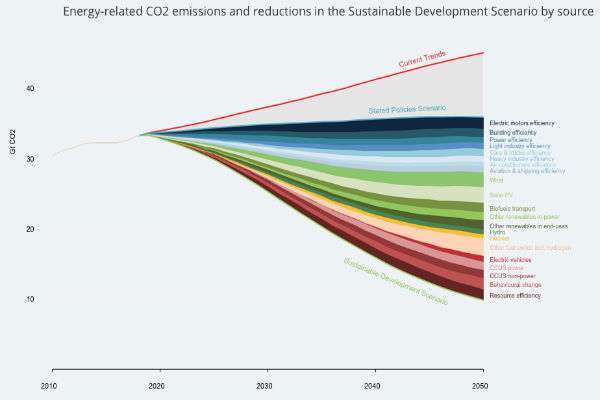We Likely Won't Cut Carbon Dioxide Emissions 45 Percent by 2030
The "New World Energy Outlook" report by the International Energy Agency suggests global warming is here to stay.

In order to have a good chance of preventing global average temperatures from exceeding 1.5°C by 2100, the Intergovernmental Panel on Climate Change's Global Warming of 1.5°C report issued in October, 2018, asserted that global net anthropogenic CO2 emissions must decline by about 45 to 50 percent from 2010 levels by 2030 (and reach net zero around 2050). This is not going to happen, if the new International Energy Agency's World Energy Outlook 2019 (WEO) report is to be believed.
The WEO projects future energy consumption and emissions trajectories using three different scenarios. In the current trends scenario, countries make no additional efforts to curb fossil fuel consumption and associated emissions. In the stated policies scenario, the agency presumes that all countries will mostly abide by the commitments they've made with respect to reducing fossil fuel consumption and carbon dioxide emissions. And the third sustainable development scenario incorporates a set of ambitious policies that assumes significant gains in energy efficiency, the expansive deployment of renewable power generation, carbon capture, and sequestration technologies.
Since most of the IEA report is behind a paywall, let's rely on the data supplied by the invaluable Carbon Brief to set out the scenarios.
In the "current policies" scenario, world energy consumption grows at 1.3 percent per year and global carbon dioxide emissions continue rising through 205,0 which is the year that the IPCC 1.5°C report says that the world needs to reach net-zero emissions.

In "stated policies," the IEA projects that global energy consumption will rise by 1 percent per year until 2040, which is half the 2 percent rate of growth between 2000 and 2018. About half of that consumption increase will be supplied by renewables and one-third by natural gas. While global carbon dioxide emission growth slows, it would nevertheless rise from 34.7 gigatons in 2017 to 37.1 gigatons in 2030. Global emissions were about 32 gigatons in 2010, so a 45 percent cut means that emissions would have to fall by 14.4 gigatons by 2030.
Are countries likely to fulfill their stated energy and emissions policies? A new analysis just released by the Universal Ecological Fund, The Truth Behind the Climate Pledges, strongly suggests that this is a doubtful prospect. The report notes that "at least 130 nations, including four of the top five world's largest emitters, are falling far short of contributing to meeting the 50 percent global emissions reductions required by 2030 to limit global temperature increase to 1.5°C above pre-industrial levels."
Even in the IEA's ambitious Sustainable Development scenario, global CO2 emissions decline to 17 percent below 2010 levels by 2030, 48 percent by 2040, and 68 percent by 2050. According to the IEA, this puts the world "on course for net-zero emissions by 2070," which has a 50 percent chance of limiting average warming to 1.65°C above pre-industrial levels.
Man-made climate change is a big problem, but the new IEA report persuasively shows that steep, immediate cuts in global energy consumption and carbon dioxide emissions are a pipe dream.


Show Comments (130)